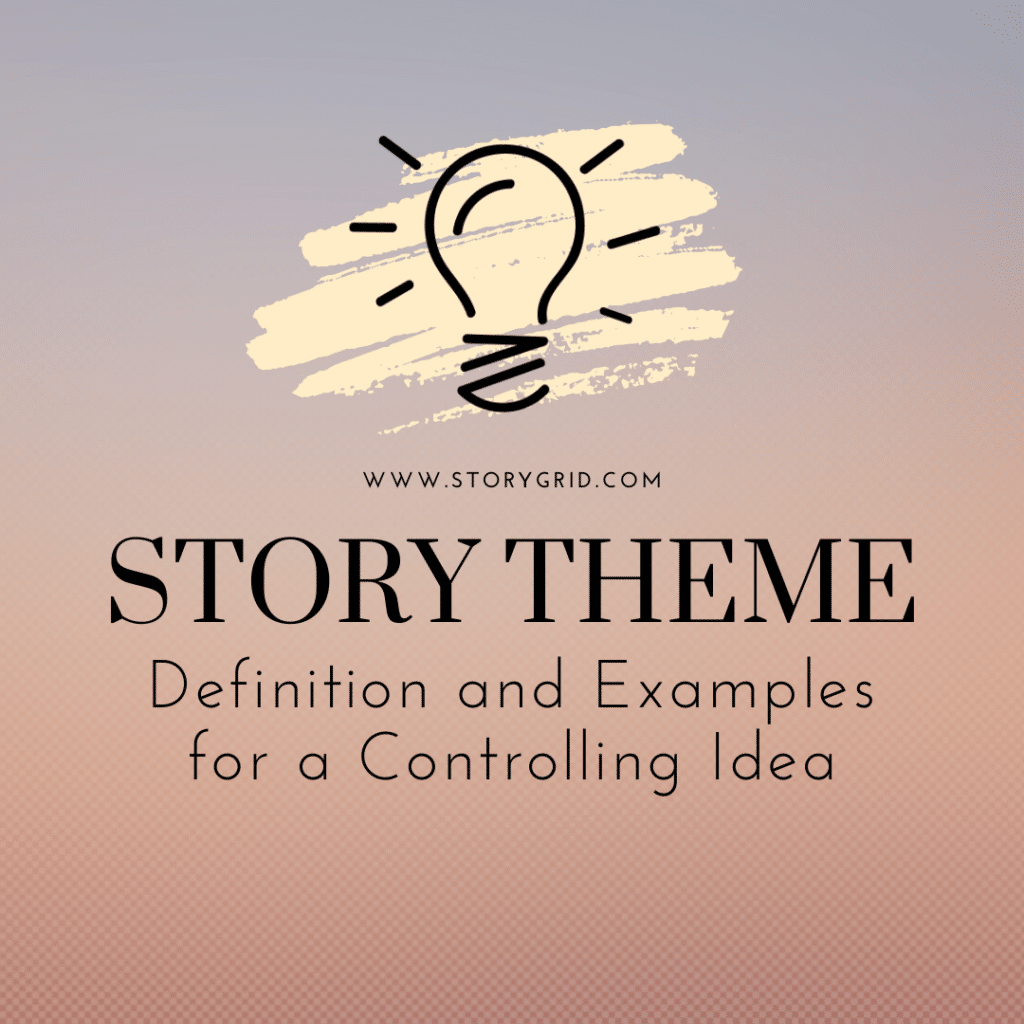What is the Story Theme definition?
The story theme is the takeaway message the ARTIST wants the SINGLE AUDIENCE MEMBER to discover from reading the story. It is the deeply held truth we are embedding into our story. It is the change the AUTHOR is trying to evoke in the reader.
The story theme is tightly coupled to the the VALUE at stake in our global GENRE. For example, if we are telling an ACTION story, our controlling idea will involve life and death. If it’s a CRIME story, justice and injustice. If it’s a LOVE story, love and hate, and so on.
At Story Grid we refer to the story theme as the controlling idea of a story because every UNIT OF STORY should be guided by this message. Every CRISIS the protagonist faces should relate to the controlling idea.
As we create our story, our controlling idea should guide every sentence we write.

How to Identify and Refine Your Controlling Idea (or Theme)
Often the final theme of a story will not crystallize for the ARTIST until after finishing and reading the first full draft. However, there are a few initial steps we can take to create a placeholder controlling idea to use throughout the creation of our first draft.
Step 1: Identify the Genre
Every GENRE has a built in controlling idea or theme that is tied to the VALUE at stake in that genre.
- Action – Life / Death
- War – Honor / Dishonor
- Horror – Life / Damnation
- Crime – Justice / Injustice
- Thriller – Salvation / Damnation
- Love – Love / Hate
- Performance – Respect / Shame
- Western / Eastern – Freedom / Subjugation
- Society – Power / Impotence
- Status – Success / Failure
- Morality – Altruism / Selfishness
- Worldview – Sophistication / Naivety
Step 2: Choose between a Prescriptive or Cautionary Story
Because the story will shift on the VALUE of your GENRE, the ARTIST must choose if the protagonist of the story will move up or down the spectrum:
- Prescriptive Story – The protagonist moves up the value spectrum (Death to Life, Naivety to Sophistication, etc)
- Cautionary Story – Your protagonist moves down the value spectrum (Justice to Injustice, Success to Failure, etc)
In the final CRISIS of a story, the protagonist faces a binary choice that is decided by the GENRE. Will the protagonist choose to move up or down the VALUE spectrum in the end? What final CLIMAX will the protagonist choose?
Step 3: Fill in the Blank
Now take the answers from the two previous steps and insert them here to build your controlling idea.
→ [VALUE] prevails when we choose [ACTION TAKEN BY PROTAGONIST].
Examples:
- SUCCESS prevails when we choose TO LAY EVERYTHING ON THE LINE.
- INJUSTICE prevails when we choose PERSONAL SAFETY OVER DOING WHAT IS RIGHT.
- FREEDOM prevails when we choose GIVE OUR LIFE TO FIGHT TYRANNY.
While this process will not produce a final version of a controlling idea for our specific story, it will allow us to start writing our first draft with a solid guide in mind.
Once we finish the first draft, Story Grid recommends working with an EDITOR to refine the controlling idea based on the story. This will allow us to create a second draft that more tightly adheres to the final controlling idea.
Examples of Controlling Ideas (or Themes) in Story
- The Bluest Eye by Toni Morrison (Society)
Cruel and oppressive behavior prevails when the innocence of the youth is stifled and disregarded. - A Farewell to Arms by Ernest Hemingway (Morality)
Meaninglessness reigns when we choose selfishness over responsibility and commitment. - The Picture of Dorian Gray by Oscar Wilde (Morality)
Evil reigns when one pursues selfish ends at the expense of others. - The Grapes of Wrath by John Steinbeck (Society)
Tyrants will continue to beat back revolutions until individuals seize their own agency and act in the interest of the many, regardless of their own fate. - Twilight by Stephanie Meyer (Love)
Love wins when you put your partner’s needs before your own. - Eagle Has Landed by Jack Higgins (War)
Honor means keeping your word and respecting common humanity even when facing certain death. - Beat to Quarters by C.S. Forester (Action)
Life is preserved when captains prioritize their crew above orders and their own ambitions or desires. - The Shining by Stephen King (Horror)
When we cannot overcome the cyclical psychic wounds of abuse, addiction, jealousy, and family dysfunction, evil and our inner demons can overcome our better selves, resulting in terror and death. - Knots and Crosses by Ian Rankin (Crime)
Justice prevails when detectives face their past and release their shadow to stop a deranged killer in time.
Additional Resources
Non-Negotiable
The Problem in Your Story
Controlling Ideas in Nonfiction
Share this Article:
🟢 Twitter — 🔵 Facebook — 🔴 Pinterest
Sign up below and we'll immediately send you a coupon code to get any Story Grid title - print, ebook or audiobook - for free.
(Browse all the Story Grid titles)